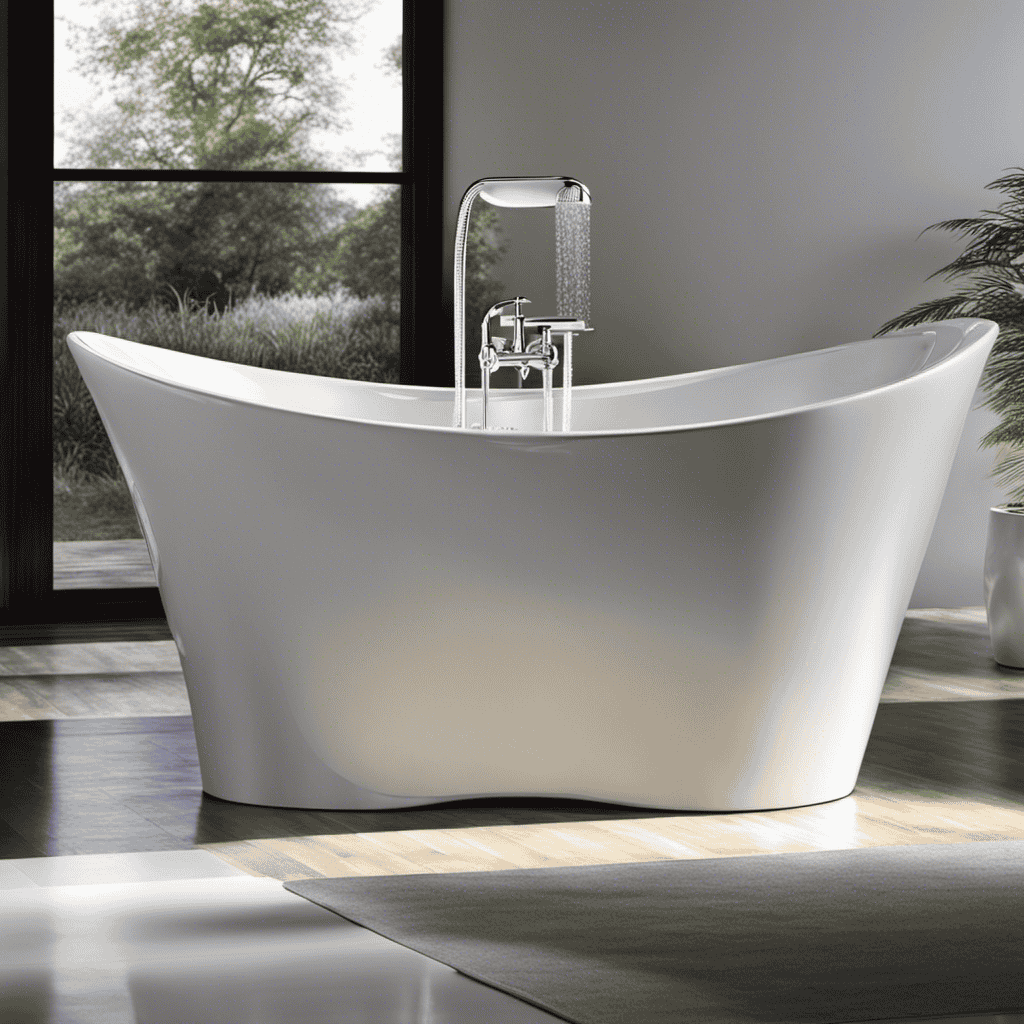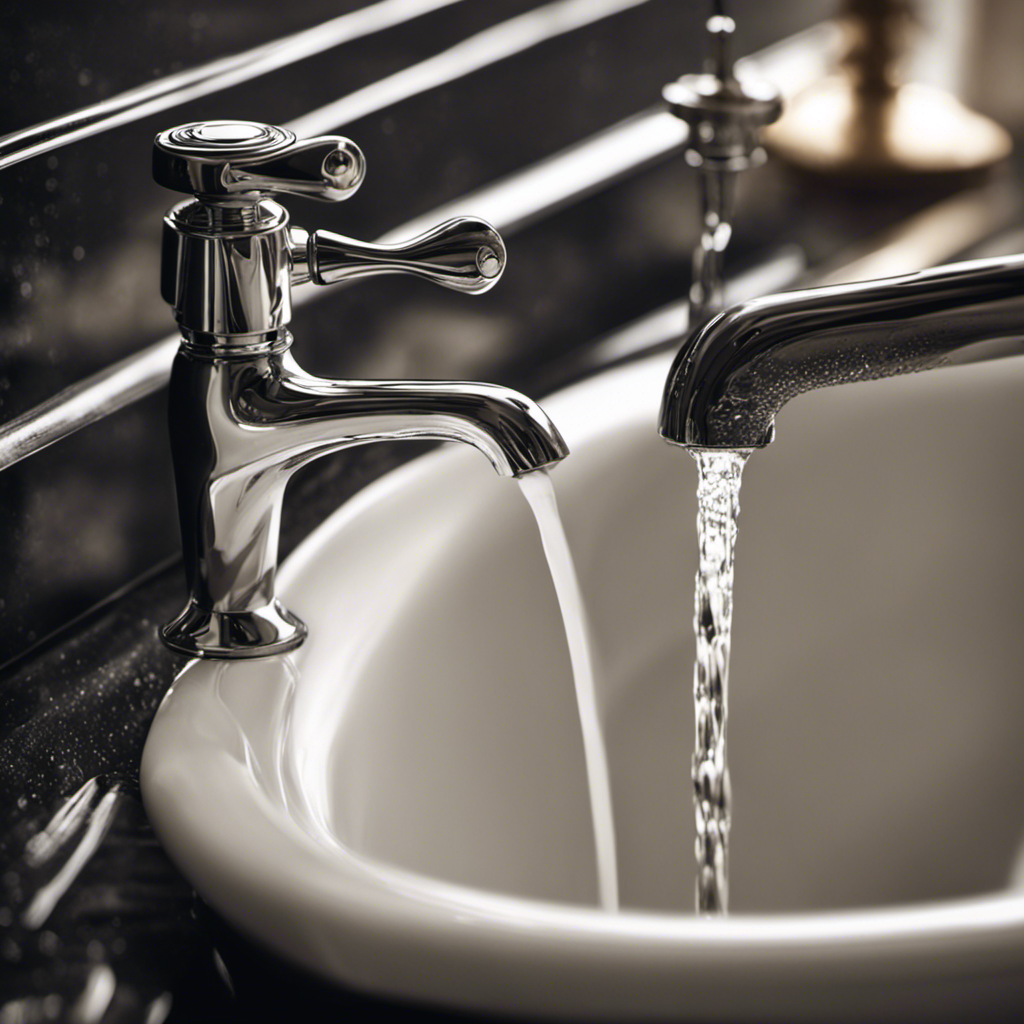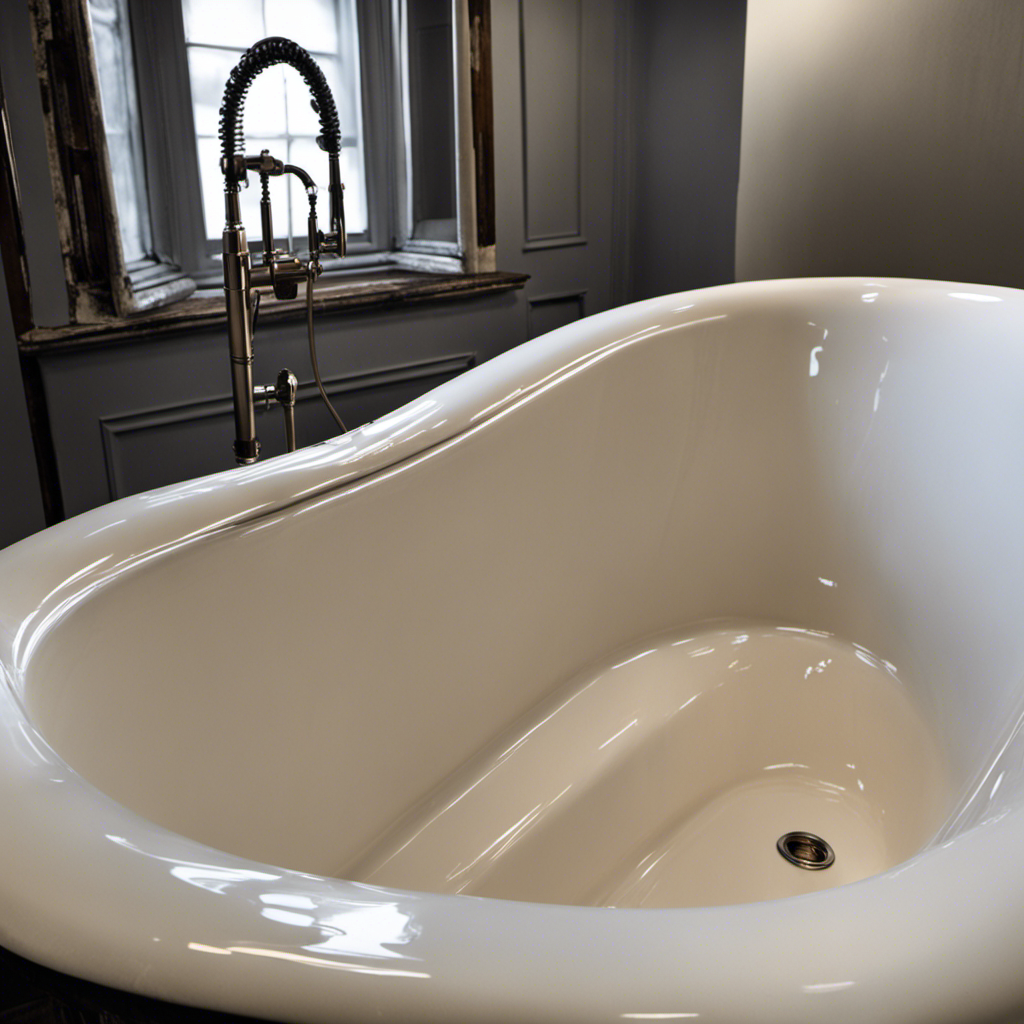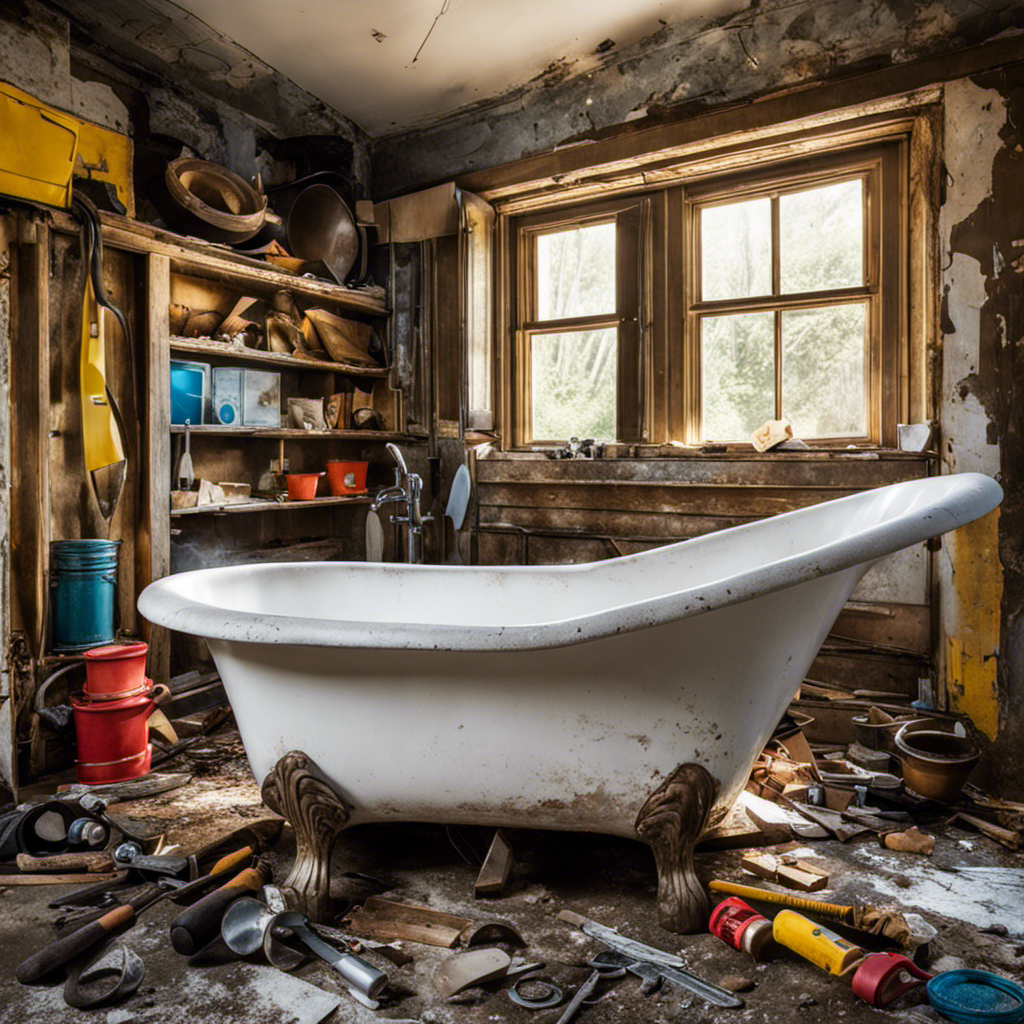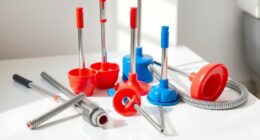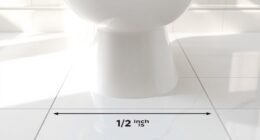Do you find yourself frustrated by a constantly dripping bathtub faucet? You’re not alone.
In fact, did you know that a single faucet leak can waste up to 3,000 gallons of water per year? That’s enough to fill 45 bathtubs!
But fear not, because in this article, we’ll guide you through the common causes of dripping faucets, teach you how to identify a leak, and provide step-by-step instructions on fixing the issue.
With a few simple tools and some know-how, you’ll be able to put an end to that annoying drip once and for all.
Key Takeaways
- Dripping bathtub faucets can be caused by worn-out washers, improperly tightened components, low-quality replacement parts, damaged valve stems, and loose connections.
- Signs of a dripping bathtub faucet include a constant sound of water or a higher water bill, visible drips or water pooling around the faucet, and the dripping stopping when the water supply is turned off.
- To fix a dripping bathtub faucet, gather necessary tools and materials, turn off the water supply, remove the faucet handle, access and inspect the cartridge or valve stem, and clean, lubricate, or replace the cartridge or valve stem.
- Tools needed for repairing a leaky bathtub faucet include an adjustable wrench, screwdriver, and pliers.
Common Causes of Dripping Bathtub Faucets
One of the most common causes of dripping bathtub faucets is a worn-out washer. When the washer in a faucet becomes worn, it can no longer create a tight seal, resulting in water leakage.
To identify faucet leaks, start by turning off the water supply and inspecting the faucet for any visible signs of leakage. Look for water dripping from the spout or pooling around the base of the faucet.
Another common mistake in faucet repair is not properly tightening the faucet components. Be sure to use the correct tools and tighten all screws and connections securely.
Additionally, using low-quality replacement parts can lead to further leaks and issues. It is essential to use high-quality, compatible parts for effective faucet repair.
How to Identify a Leaking Bathtub Faucet
To identify a leaking bathtub faucet, you can start by checking if there’s a constant sound of water and if your water bill has been higher than usual. These are often telltale signs of a leak.
Another way to check is by examining the faucet itself. Look for any visible drips or water pooling around the base of the faucet. You can also try turning off the water supply to the faucet and see if the dripping stops. If it does, then the issue is likely with the faucet and not a larger plumbing problem.
Additionally, you can troubleshoot faucet problems by inspecting the handles and valves for any damage or wear.
Identifying water leaks and troubleshooting faucet problems requires careful observation and attention to detail.
Steps to Fix a Dripping Bathtub Faucet
You can start fixing a dripping bathtub faucet by gathering the necessary tools and materials.
The first step is to turn off the water supply to the faucet. You can usually find the shut-off valve under the sink.
Next, you will need to remove the handle of the faucet. This can usually be done by unscrewing a small screw or by prying off a decorative cap and then unscrewing the handle.
Once the handle is removed, you can access the cartridge or valve stem. This is often the cause of a dripping faucet and may need to be replaced. If the cartridge or valve stem is in good condition, you may just need to clean it and apply fresh lubricant before reassembling the faucet.
Finally, turn the water supply back on and check for any leaks. Common causes of dripping bathtub faucets include worn-out cartridges, damaged valve stems, and loose connections.
Tools You’ll Need to Repair a Leaky Bathtub Faucet
The tools you’ll need to fix a leaky bathtub faucet include an adjustable wrench, a screwdriver, and a pair of pliers. These essential tools will enable you to successfully repair your dripping bathtub faucet and prevent any further water waste. Here’s a handy table outlining the tools you’ll need and their specific uses:
| Tool | Use |
|---|---|
| Adjustable wrench | Tightening or loosening nuts |
| Screwdriver | Removing screws |
| Pliers | Gripping and turning components |
To fix a leaky bathtub faucet, start by turning off the water supply to the faucet. Use the adjustable wrench to remove the handle and expose the cartridge or valve beneath. Use the screwdriver to remove any screws holding the cartridge or valve in place. Inspect the cartridge or valve for any signs of wear or damage, and replace if necessary. Reassemble the faucet, turn on the water supply, and test for leaks. By following these steps and using the right tools, you’ll be able to fix your bathtub faucet and enjoy a drip-free bathing experience once again.
Tips for Disassembling a Dripping Bathtub Faucet
When disassembling a leaky bathtub faucet, start by locating the handle and removing it with the adjustable wrench. This will allow you to access the inner workings of the faucet and troubleshoot the issue.
Before you begin, make sure to turn off the water supply to prevent any accidents.
Once the handle is removed, use a screwdriver to unscrew the escutcheon plate and expose the valve stem. Carefully remove the valve stem and inspect it for any signs of damage or wear.
If you notice any faulty washers or o-rings, this is likely the cause of the leak. In the next section, we will discuss how to replace these faulty parts and fix the leaking faucet.
Replacing Faulty Washers and O-Rings in a Leaking Faucet
To fix a leaky faucet, start by carefully removing the valve stem to inspect for any damaged washers or o-rings. The causes of water leakage in a dripping faucet can typically be attributed to worn-out washers or o-rings. Over time, these components can deteriorate due to constant use, leading to water seepage.
Troubleshooting a dripping faucet involves identifying the faulty washers or o-rings and replacing them. Once the valve stem is removed, examine the washers and o-rings for signs of wear, such as cracks or tears. If any damage is detected, remove the old washers or o-rings and replace them with new ones of the same size and type.
This simple maintenance task can effectively resolve the issue of water leakage, restoring the functionality of your faucet.
How to Install a New Cartridge in a Dripping Bathtub Faucet
Start by shutting off the water supply to your dripping bathtub faucet before attempting to install a new cartridge. Here’s how to do it:
-
Choosing the Right Cartridge: To ensure compatibility, check the brand and model of your faucet and consult the manufacturer’s guide or website to find the correct cartridge for your specific model.
-
Troubleshooting Common Issues: Before replacing the cartridge, troubleshoot other potential causes of the dripping, such as a loose handle, worn-out seals, or mineral buildup. Addressing these issues may save you from unnecessary cartridge replacement.
-
Installing the New Cartridge: Remove the handle, trim, and retaining nut to access the cartridge. Carefully pull out the old cartridge and insert the new one, following the manufacturer’s instructions. Reassemble the faucet, turn on the water supply, and test for leaks.
Adjusting Water Pressure to Prevent Faucet Dripping
If you’re experiencing a dripping faucet, there are a few common causes that you should be aware of.
The first cause could be a faulty cartridge or valve, which may require replacement.
Another possible cause is high water pressure, which can put strain on the faucet and cause it to drip.
To fix the issue of high water pressure, you may need to adjust the water pressure regulator or install a pressure-reducing valve.
Causes of Dripping
One of the most common causes of a dripping bathtub faucet is a worn-out washer. This small rubber or silicone disk is located inside the faucet handle and helps create a watertight seal when the faucet is turned off. Over time, the constant pressure and friction from turning the faucet on and off can cause the washer to deteriorate, resulting in a leaky faucet.
Here are three common signs that your bathtub faucet washer may be worn-out:
- The faucet drips even when it is turned off completely.
- There is a constant water puddle or stain around the faucet.
- You hear a steady dripping sound coming from the faucet.
The effects of a dripping bathtub faucet can range from annoying to costly. It can lead to water wastage, higher water bills, and potential damage to your bathtub or bathroom fixtures if left unaddressed. Additionally, the constant dripping can be a source of frustration and disturbance, especially during the night when you are trying to sleep.
It is important to address a dripping faucet promptly to avoid these negative effects.
Fixing Water Pressure
Fixing the water pressure in your bathtub can help prevent further damage and improve the overall functionality of your bathroom fixtures. Adjusting the shower temperature and fixing a leaking showerhead are essential steps to take to ensure a comfortable and efficient bathing experience. By addressing these issues, you can avoid scalding or freezing water temperatures and prevent wastage of water due to leaks.
To give you a better understanding of the importance of fixing water pressure, here is a table showcasing the potential consequences of neglecting this problem:
| Consequences of Low Water Pressure | ||
|---|---|---|
| Inadequate rinsing of shampoo and soap | Unpleasant showering experience | Reduced water flow in the bathtub |
Regular Maintenance to Avoid Bathtub Faucet Drips
Are you tired of dealing with annoying faucet leaks in your home? In this discussion, we will explore effective ways to prevent faucet leakage and tackle DIY faucet repairs.
By understanding the common causes of leaks and following some simple maintenance tips, you can save yourself time, money, and frustration in the long run.
Whether you’re a beginner or have some experience with plumbing, this discussion will provide you with the knowledge and skills to keep your faucets in excellent working condition.
Preventing Faucet Leakage
To prevent faucet leakage, you should regularly check and tighten the connections. This simple maintenance task can help you avoid water wastage and save on your utility bills.
Here are three reasons why timely faucet repairs are important:
-
Prevent water wastage: A leaking faucet can waste a significant amount of water over time. By fixing the leak promptly, you can conserve this precious resource and contribute to environmental sustainability.
-
Save money: Every drop counts when it comes to your water bill. Fixing a leaky faucet can help you save money by reducing your water consumption and preventing unnecessary expenses.
-
Maintain a functional bathroom: A leaking faucet can be annoying and disrupt your daily routine. By addressing the issue promptly, you can ensure that your bathroom remains a comfortable and functional space.
DIY Faucet Repair
Now that you understand how to prevent faucet leakage, it’s time to tackle any existing problems with a DIY approach.
Don’t worry, troubleshooting faucet problems is easier than you might think.
If your bathtub faucet is dripping when it’s supposed to be off, there are a few things you can check before calling a professional.
First, ensure that the faucet handle is fully turned off. Sometimes, a loose or worn-out handle can cause water to continue flowing.
If the handle is secure, the issue may lie within the cartridge or valve. You can try replacing these components yourself by following the manufacturer’s instructions.
If the problem persists, it may be time to consult a plumber. However, with a little DIY faucet installation knowledge and troubleshooting skills, you may be able to fix the issue on your own.
Frequently Asked Questions
How Can I Tell if My Bathtub Faucet Is Dripping When It’s Turned Off?
To determine if your bathtub faucet is dripping when it’s turned off, first, make sure the water is completely shut off. Then, observe the faucet for any signs of water leakage or a continuous drip. If you notice any, it’s time to consider bathtub faucet repair and troubleshooting dripping faucets.
Can a Dripping Bathtub Faucet Cause Water Damage?
A dripping bathtub faucet can indeed cause water damage if left unaddressed. To prevent this, regularly check for leaks and address them promptly. Common causes of leaks include worn-out washers or faulty valves.
Is It Possible for a Dripping Bathtub Faucet to Increase My Water Bills?
If your bathtub faucet is dripping when off, it can definitely increase your water bills. This is one of the common causes of dripping faucets. To conserve water and save money, consider fixing the issue or calling a professional plumber.
Are There Any Temporary Fixes for a Dripping Bathtub Faucet?
To temporarily fix a dripping bathtub faucet, you can tighten the handle or replace the washer. First, turn off the water supply. Then, use a wrench to tighten the handle or replace the worn washer.
Can a Dripping Bathtub Faucet Be a Sign of a Bigger Plumbing Issue?
A dripping bathtub faucet can indicate a larger plumbing issue. Common causes include worn-out washers or faulty valves. To fix it, you can try replacing the washers or call a professional plumber for assistance.
Conclusion
In conclusion, fixing a dripping bathtub faucet is a common issue that can be easily resolved with a few simple steps. By identifying the cause of the leak and using the right tools, you can quickly repair the faucet and prevent further damage.
Did you know that a dripping faucet can waste up to 3,000 gallons of water per year? Taking prompt action to fix a leaking bathtub faucet not only saves water, but also helps you save money on your water bill.
So don’t let that drip continue, take action today and enjoy a leak-free bathtub faucet.
